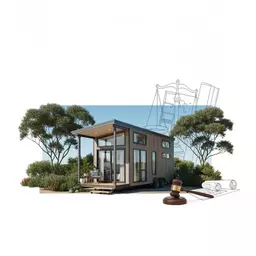Fixed Tiny Homes
Permanent structures built on foundations that require building permits and must comply with local building codes.
Get expert advice, innovative design ideas, and practical tips for your tiny home journey in Australia.
Posted on: 2025-10-29
By: Sophie Marchant
As the tiny home movement gains momentum in Australia, the legal landscape can feel daunting. However, navigating the complexities of laws and regulations doesn’t have to be overwhelming. Gaining a clear understanding of the legal implications surrounding tiny homes is crucial for aspiring builders, and this journey is not just about constructing a house—it's about creating a sustainable lifestyle that aligns with your values.
Explore the key differences between Fixed Tiny Homes and Tiny Homes on Wheels (THOWs) in navigating the legal landscape for tiny homes in Australia.
Permanent structures built on foundations that require building permits and must comply with local building codes.
Mobile dwellings that can be towed. They may be subject to vehicle registration and road safety standards.
Follow these critical steps to ensure you secure necessary approvals for your tiny home.
Familiarize yourself with the specific guidelines and regulations for tiny homes in your area.
Include layout plans and any necessary documentation for environmental assessments.
Be aware of common challenges that may arise during the approval process.
Variability in zoning laws between councils can create confusion and complications.
Some neighbors may not understand or support tiny living and its benefits.
The rise of tiny homes in Australia has been exciting! More people are embracing the idea of downsizing, simplifying their lives, and living sustainably. However, with this growing interest comes a complex web of legal challenges that can be tricky to navigate. Many aspiring tiny homeowners find themselves asking: what are the legal requirements? How do I ensure my tiny home complies with local laws? I’m here to break it down for you!
In recent years, tiny homes have captured the imagination of many Australians. People are drawn to the idea of minimalism and the freedom it brings. Yet, the legal landscape surrounding tiny homes is not straightforward. Numerous challenges exist, including zoning laws, building codes, and local regulations that vary widely across the country.
As someone who is passionate about the tiny house movement, I often see questions arise around these legal complexities. Here are a few challenges to keep in mind as you embark on your tiny living journey:
Before diving into the legalities, it’s essential to define what a tiny home is. In Australia, tiny homes can generally fall into two categories: fixed tiny homes and tiny homes on wheels (THOWs). Understanding these distinctions is crucial because the legal requirements often differ significantly between the two.
Here’s a quick overview of the differences:
Knowing the definition helps ensure you’re on the right track! Whether you choose a fixed tiny home or a THOW, understanding the legal implications will set the foundation for a smooth journey. For more comprehensive information on tiny home regulations, explore our guide on navigating tiny house zoning.
Once you have a clear understanding of what type of tiny home you want, the next step is navigating development approvals and building permits. This can seem daunting, but I promise it’s manageable when broken down into clear steps!
The Development Application (DA) process is a critical step in securing your tiny home’s legality. It typically involves submitting plans for your build and demonstrating compliance with local planning laws. Here are some essential elements to keep in mind:
Many tiny home enthusiasts find success by connecting with local councils early in the process. Have you thought about reaching out for guidance? It can make a world of difference!
Building permits are another vital aspect of tiny home construction. These permits ensure that your home meets the Building Code of Australia (BCA) standards. Complying with these regulations is essential for safety, structural integrity, and insurance purposes. Here are key considerations when seeking building permits:
Don’t let the permit process intimidate you! With proper preparation, you can navigate these requirements effectively. To learn more about specific requirements, check out our article on obtaining tiny house permits.
Lastly, let’s touch on the key planning regulations that affect tiny homes. These regulations can significantly influence where and how you can place your tiny home. Some critical factors include:
Understanding these planning regulations will help you find the perfect spot for your tiny home. It’s all about aligning your dream with local laws!
Here's a brief recap of the key points discussed so far:
Here are some common questions and answers about navigating the legal landscape for tiny homes in Australia:
When it comes to tiny homes, real-life stories are incredibly inspiring! I love sharing examples of people who have successfully navigated the approval process for their tiny homes. These stories not only highlight the possibilities but also provide valuable lessons for those of you considering this lifestyle. Let’s explore some of these successful tiny home approvals across various councils in Australia.
Many individuals have achieved their dreams of tiny living by securing approval from local councils. Here are a few notable case studies:
These examples show how creativity and thorough preparation can lead to successful tiny home approvals! Each case offers insights into what worked and what could have been done differently.
While many have succeeded, the path to securing a tiny home approval can be bumpy. Here are some common challenges that people face:
Overcoming these hurdles requires patience and strong communication. It's essential to do your homework and be willing to engage with local councils. Engaging with others in the tiny home community can also provide helpful support and advice! For more details on zoning, explore our comprehensive guide on tiny house zoning laws explained.
As you consider the journey of building your own tiny home, remember that you’re not alone. Each step brings you closer to your dream of sustainable living! Now, let’s look at some practical next steps to get you started.
Finding the right resources is crucial for your tiny home journey. Here are a few places to start:
Taking advantage of these resources will help you navigate local regulations with greater ease.
Once you’ve gathered information, it’s time to take action! Here’s how you can engage with local planners and certifiers:
Each interaction is an opportunity to learn and refine your approach! For further reading, check out our article on financing your tiny house purchase.
Building surveyors and certification bodies play a significant role in ensuring tiny homes meet safety and compliance standards. Here’s what you should know:
Connecting with these professionals early in your journey can save you time and stress down the line!
By taking these steps and leveraging the resources available, you’ll be well on your way to crafting your dream tiny home. Join the thriving community of tiny home enthusiasts, and let’s navigate this exciting journey together! What are your thoughts so far? Are you ready to embark on your tiny living adventure?
Here is a quick recap of the important points discussed in the article:

 What if your small living space could also be a sanctuary for the planet? Embracing sustainability n
What if your small living space could also be a sanctuary for the planet? Embracing sustainability n
 As the tiny home movement gains momentum in Australia, the legal landscape can feel daunting. Howeve
As the tiny home movement gains momentum in Australia, the legal landscape can feel daunting. Howeve
 Did you know that zoning laws can significantly impact the feasibility of sustainable housing initia
Did you know that zoning laws can significantly impact the feasibility of sustainable housing initia